I had a hard time choosing the second article to bring back for this “Best Of. . .” feature. Should I go zany, and choose the Space Bears? Should I try to claim that I had Thundercats-style “sight beyond sight” when I featured Crisis Doom the month before it finished second at PC: LA in the hands of Ryan Jones? In the end, I decided to go with a deck featuring Checkmate, a team that is threatening to overtake my beloved League of Assassins in the “favorite team” stakes. The deck in question was the Accelerated Stall deck originally featured in September, which brought together an eccentric mix of teams (Checkmate, the Fantastic Four, the New Gods, and Underworld) to produce a deck that turned out to be surprisingly effective. Everything worked well together, and the deck was capable of exerting what may be an unprecedented level of control over the “effective” turn count. When recruiting Asmodeus or Takion ◊ Highfather on turn 6, the resource count by the end of the turn could be anywhere from four to eight. Control decks got nuked out of Golden Age and right back into the Stone Age, and aggro decks were confronted by an unexpected and very angry Ghost Rider or Silver Surfer. It was a blast to test, and I hope you’ll find it just as entertaining to take out for a spin!

Today’s edition of Deck Clinic features a team close to my heart. (Not as close as the League of Assassins, but what team without ninjas ever could be?) Checkmate has become the team de jour for any just-crazy-enough idea that happens to benefit from easy access to locations, and this deck is no exception.
Submitter: Akugyaku on VsRealms.com
Characters
3 Jacob Lee, Knight
3 Black Thorn, Elizabeth Thorne
2 Sarge Steel, Knight
4 Serifan, Forever People
4 Ahmed Samsarra, White King
3 Invisible Woman, Sue Storm
1 Adrian Chase ◊ Vigilante, Street Justice
1 Commander, Military Leader of New Genesis
1 Metron, Time Traveler
1 Maxwell Lord, Black King
2 Huntress, Reluctant Queen
1 Takion ◊ Highfather, Josh Saunders
1 Sasha Bordeaux, Autonomous Prototype
1 Silver Surfer, Norrin Radd
1 Trigon, The Terrible
Plot Twists
4 Enemy of My Enemy
2 Threat Neutralized
2 Straight to the Grave
3 Revitalize
2 Lanterns in Love
Locations
1 New Genesis
1 Checkmate Armory
4 Brother I Satellite
3 Checkmate Safe House, Team-Up
1 Slaughter Swamp
1 UN Building
2 Brother Eye
2 The Source
1 Rook Control
Equipment
1 Catcher’s Mitt
2 Mobius Chair
Here’s my crazy deck. Move Serifan, Forever People (with cosmic counter) and Invisible Woman, Sue Storm to the hidden area, then use recovery effects on your visible characters. No damage ever! Takion ◊ Highfather, Josh Saunders skips to eight resources, then Silver Surfer, Norrin Radd and Trigon, The Terrible take over.
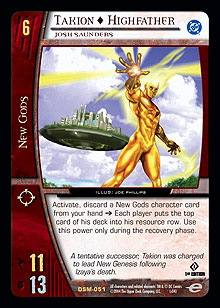 The concept is pretty simple: prevent early damage through a mix of reinforcement, invulnerability, and recovery effects before recruiting and protecting Takion ◊ Highfather, Josh Saunders on turn 6; skip turn 7; then recruit Silver Surfer, Norrin Radd on turn “7” and keep a tight grip on the initiative for the rest of the game. The finisher of choice for Akugyaku’s original build (if anything is needed on top of Silver Surfer) is Trigon, the Terrible, a huge beater that also allows you to steal all of your opponent’s locations at the start of the combat phase. Trying to accelerate the game while otherwise acting like a stall deck is an interesting concept.
The concept is pretty simple: prevent early damage through a mix of reinforcement, invulnerability, and recovery effects before recruiting and protecting Takion ◊ Highfather, Josh Saunders on turn 6; skip turn 7; then recruit Silver Surfer, Norrin Radd on turn “7” and keep a tight grip on the initiative for the rest of the game. The finisher of choice for Akugyaku’s original build (if anything is needed on top of Silver Surfer) is Trigon, the Terrible, a huge beater that also allows you to steal all of your opponent’s locations at the start of the combat phase. Trying to accelerate the game while otherwise acting like a stall deck is an interesting concept.
As you may have picked up from my articles on the development of Deep Green, when you have access to a search card core as substantial as the Ahmed Samsarra / Brother I Satellite / Enemy of My Enemy one, you have to take a very different approach to building your curve. More emphasis has to be placed on your key earliest drops, but you can afford to skimp on later ones and run single copies of various, interesting, on-team characters because you always have access to your primary drops via Ahmed searching for Brother I Satellite. Akugyaku’s original build runs along the right lines: single copies of higher drops that can be searched out with Satellites once Ahmed is established, and higher numbers of the lower drops. I do, however, think there are some useful changes that can be made across the curve.
Curve-building for Dummies Kings
1-drops
The New Gods have only a single 1-drop, Soldiers of New Genesis, Army, which isn’t particularly appealing. The Fantastic Four have Invisible Woman, The Invisible Girl, who is probably not worth including without her hubby and A Child Named Valeria. Checkmate has Jacob Lee, Knight, whose alternate recruit cost makes him worth noting. Early drafts of Deep Green contained a copy of Jacob to help make Rook Control work more smoothly, and he may find a place here doing the same job.
2-drops
When building an Ahmed-enabled curve, special consideration needs to be given to the primary off-team 2-drop, as this will determine which characters you can access most easily on turn 4 with an Ahmed-fetched Brother I Satellite. In our case, the 4-drop we’re likely to want is one of the Fantastic Four, Invisible Woman, Sue Storm. As such, if there’s a Fantastic Four 2-drop that supports our game plan, we will want to consider including it. A quick look at the available options suggests She-Thing, Sharon Ventura. She has the 3 ATK / 3 DEF stats I always look for in a 2-drop and an ability that will actually do more to protect our endurance total than might first be suspected. The reason for this is that in Golden Age, one of the most substantial drains on our endurance total is actually not breakthrough endurance loss, but rather equipment like Advanced Hardware and Flamethrower, most notably in High Voltage. While She-Thing can’t prevent our opponent from activating once, she can ensure that our opponent won’t be able to take bites out of our endurance turn after turn. She also prevents a Good Guys opponent from getting maximum use out of Nth Metal and can remove Utility Belts that might interfere with Ahmed Samsarra or our various location payment powers.
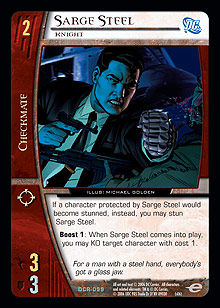 On-team, I’m a big fan of Sarge Steel, Knight. Another 3 ATK / 3 DEF character, he doesn’t have the loyalty—reveal of Black Thorn, Elizabeth Thorne. His ability is also useful, whether it’s allowing our character with range to attack without stunning, or standing in front of Invisible Woman, Sue Storm to provide a wall of guaranteed-reinforced defenders.
On-team, I’m a big fan of Sarge Steel, Knight. Another 3 ATK / 3 DEF character, he doesn’t have the loyalty—reveal of Black Thorn, Elizabeth Thorne. His ability is also useful, whether it’s allowing our character with range to attack without stunning, or standing in front of Invisible Woman, Sue Storm to provide a wall of guaranteed-reinforced defenders.
Looking at the New Gods, Serifan, Forever People is certainly interesting. The global invulnerability he provides to our characters when we’re teamed-up can represent a huge chunk of endurance if we can sustain it. The problem is his tiny stats. At 2 ATK / 2 DEF, he’s unlikely to survive long enough to provide serious benefit against the more aggressive decks in the format. Although we can recover him and put his cosmic counter back with New Genesis, that can get extremely expensive in terms of cards. Vykin, Forever People is also interesting. He provides an alternate route for locking down problematic equipment and is also potentially devastating against the Teen Titans because he is able to lock down characters like Hank Hall ◊ Hawk, Agent of Chaos, Dawn Granger ◊ Dove, Agent of Order, and Tim Drake ◊ Robin, Young Detective. As with Serifan, the difficulty lies in keeping him around long enough, although his stats are better (range and 3 DEF make him substantially more durable than Serifan . . . at least he won’t be taken down unaided by 1-drops).
Turning back to Jacob Lee, he provides fuel for a card that came to mind when trying to think of how best to make use of Vykin and Serifan. The card in question is Children of Forever, which can be played in the recovery phase to return a New Gods character to hand before putting a character card with the Forever People version into play. This lets us put Serifan into play in the recovery phase leading into a late-game turn or deploy Vykin to lock down multiple 1- and 2-drops on turn 4 against Titans, High Voltage, or control and combo decks based around large boards of cheap characters. The difficulty is that we’d need to find a way to draw into Children of Forever reliably. Sadly, Checkmate, Fantastic Four, and New Gods don’t provide any options for searching out plot twists, so for now, that idea will be shelved as too card-intensive and fiddly.
Skipping back to 1-drops for a second, a single copy of Connie Webb, Knight is useful insurance to buffer our chances of hitting Ahmed and turning a Brother I Satellite into both Ahmed and a Checkmate character to fulfill his loyalty—reveal; all at the cost of 1 resource point and one draw. Realistically, she acts as a 2-drop most of the time, as that’s the turn on which you can flip Brother I Satellite to search for her.
3-drops
At 3, Ahmed is the only character we ever want to recruit. I’m a big fan of the “Ahmed or bust” plan, but the New Gods actually give us a peculiar and unique option as a fifth 3-drop. Quite hefty at 4 ATK / 7 DEF (although unable to attack alone), Sturmer, War Dog will earn a slot for a different reason: he can be discarded, along with another card, to search for a New Gods character card with a cost of 6 or higher. While I generally loathe including 3-drops secondary to Ahmed in decks built around him, Sturmer is an interesting exception because he serves double duty as what Ian Vincent likes to call a “walking plot twist.” The fact that he is discarded rather than removed from the game to search for a character means that, with Slaughter Swamp, he can search for multiple characters over the course of a single game (perhaps a copy of Huntress, Reluctant Queen early on, then Silver Surfer or Takion ◊ Highfather later on).
4-drops
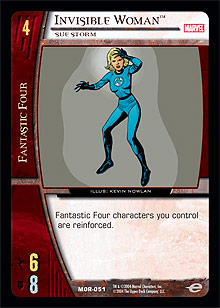 Invisible Woman, Sue Storm will stay because her global reinforcement effect will help get us to the later turns. With Serifan currently on the bench, there’s less justification for Commander, Military Leader of New Genesis. Replacing him will be Izaya ◊ Highfather, The Inheritor. He has better stats than Sue Storm does and his built-in recovery effect is powerful. Including Izaya also encourages us to look again at Vykin, as Izaya can recover Vykin at the start of recovery, enabling his payment power. Adrian Chase ◊ Vigilante, Street Justice has a powerful backup ability, but a concealed 4-drop leaves us open to quite significant amounts of breakthrough endurance loss. Elimination Protocol ◊ OMAC Robot, Army has stats as underwhelming as ever, but this deck is already looking like it will have quite substantial discard costs to keep it ticking over, and Brother Eye combined with OMAC Robots provides one route to recovering some hand size. We also need a certain number of Checkmate characters to satisfy Ahmed’s loyalty—reveal.
Invisible Woman, Sue Storm will stay because her global reinforcement effect will help get us to the later turns. With Serifan currently on the bench, there’s less justification for Commander, Military Leader of New Genesis. Replacing him will be Izaya ◊ Highfather, The Inheritor. He has better stats than Sue Storm does and his built-in recovery effect is powerful. Including Izaya also encourages us to look again at Vykin, as Izaya can recover Vykin at the start of recovery, enabling his payment power. Adrian Chase ◊ Vigilante, Street Justice has a powerful backup ability, but a concealed 4-drop leaves us open to quite significant amounts of breakthrough endurance loss. Elimination Protocol ◊ OMAC Robot, Army has stats as underwhelming as ever, but this deck is already looking like it will have quite substantial discard costs to keep it ticking over, and Brother Eye combined with OMAC Robots provides one route to recovering some hand size. We also need a certain number of Checkmate characters to satisfy Ahmed’s loyalty—reveal.
5-drops
At 5, there are a few intriguing options. The original list includes only Maxwell Lord, Black King and Metron, Time Traveler, but I actually think all of our main teams offer interesting possibilities here. Checkmate obviously gives us Annihilation Protocol ◊ OMAC Robot, Army, which is more fuel for Brother Eye to keep our hand size high. The Fantastic Four give us Thing, Heavy Hitter if we simply want a huge beater, although his loyalty is irritating. Mr. Fantastic, Stretch opens up a whole extra set of options in terms of 1-cost equipment; the most obviously interesting is Personal Force Field, which provides +3 DEF and reinforcement, though Fantasticar and the ability to move Knight Armor are worth remembering. Unfortunately, we’re unlikely to be able to search out 1-cost equipment, so Stretch’s cost-reduction power isn’t likely to be of use. The New Gods provide one other significant option at 5 in Scott Free ◊ Mister Miracle, Escape Artist. Although, as with Metron, he is hampered by loyalty and possesses slightly underwhelming stats, Scott Free’s cosmic power is extremely attractive for a deck aiming to stall out the game.
6-drops
At 6, Takion ◊ Highfather, Josh Saunders is obviously the drop of choice, allowing us to skip straight to 8 resources and Silver Surfer. Huntress, Reluctant Queen will do her usual job of negating plot twists aimed at our characters. There’s one other 6-drop that I want to include, one that I think will be necessary against the other controlling and stall decks in the format: Asmodeus, Duke of Hell, in a cameo appearance from the original Deep Green list, will allow us to choose whether to keep the game on turn “6” for a few turns (against slow decks) or skip straight to turn “8” (against more aggressive decks lacking in 8-drops or higher).
7-drops
 At 7, Akugyaku included a token copy of Sasha Bordeaux, Autonomous Prototype. Although Sasha can be searched out reliably, I’m going to bench her for this deck in favor of Thing, The Ever-Lovin’ Blue-Eyed Thing. While Sasha usually has a minimal impact on the board, TELBET can almost single-handedly turn around games. If we need for some reason to search out a Checkmate 7-drop, an Annihilation Protocol ◊ OMAC Robot with boost is perfectly serviceable.
At 7, Akugyaku included a token copy of Sasha Bordeaux, Autonomous Prototype. Although Sasha can be searched out reliably, I’m going to bench her for this deck in favor of Thing, The Ever-Lovin’ Blue-Eyed Thing. While Sasha usually has a minimal impact on the board, TELBET can almost single-handedly turn around games. If we need for some reason to search out a Checkmate 7-drop, an Annihilation Protocol ◊ OMAC Robot with boost is perfectly serviceable.
8+ drops
At the top end, I have no problem with Surfer. Trigon and Onslaught both seem like decent options at 9, although there is one difficulty in that neither has a team, so we can’t search for them without Straight to the Grave. As we don’t have any conventional card drawing, we run the risk of missing our post-8-drop. While there are no on-team options, Professor X, Mental Master has proved his worth in multiple decks and Dr. Light, Arthur Light provides an amusing possible alternative. However, with the addition of Asmodeus, our game plan essentially splits into two options on turn 6. Against aggressive or swarm decks, we want to kick the game up a turn with Takion ◊ Highfather and overpower decks unprepared to take advantage of that many resources. Against slower, more controlling decks, we now have the ability to keep the effective turn number static, or even drop the effective turn number with Asmodeus and Cosmic Radiation. As such, our second higher drop will be Ghost Rider, Danny Ketch, who is more suited to wrecking aggressive decks.
Looking back over our curve, it seems like we have a potential problem. Our best New Gods 5-drop, Scott Free ◊ Mister Miracle, Escape Artist, has loyalty. Given this, the first draft of the deck will run the full four copies of Vykin, Forever People at the 2-slot, which should combine with Izaya at 4 to give us good odds of being able to make a New Gods character with loyalty on turn 5. While Annihilation Protocol is a very strong character, it’s not at its best in a deck that is primarily defensive. If it turns out that we really need She-Thing’s higher ATK and equipment-removal power, we can take the other approach of moving back to four copies of She-Thing and rebalancing the 4-drops to make it easier to recruit our loyal 5-drops (by moving to two copies each of Invisible Woman and Izaya, for example).
One final thought: If at all possible, we’d like to get a few copies of Mr. Mxyzptlk, Troublesome Trickster into the deck. It looks like we’ll have quite a substantial number of discard costs in the deck, and there’s only so much work that Brother Eye can do.
So, a first draft of our curve:
1 Connie Webb, Knight
2 Mr. Mxyzptlk, Troublesome Trickster
4 Vykin, Forever People
1 Sarge Steel, Knight
4 Ahmed Samsarra, White King
1 Sturmer, War Dog
3 Invisible Woman, Sue Storm
2 Elimination Protocol ◊ OMAC Robot, Army
1 Izaya ◊ Highfather, The Inheritor
2 Annihilation Protocol ◊ OMAC Robot, Army
1 Maxwell Lord, Black King
1 Metron, Time Traveler
1 Scott Free ◊ Mister Miracle, Escape Artist
2 Huntress, Reluctant Queen
1 Takion ◊ Highfather, Josh Saunders
1 Asmodeus, Duke of Hell
1 Thing, The Ever-Lovin’ Blue-Eyed Thing
1 Silver Surfer, Norrin Radd
1 Ghost Rider, Danny Ketch
That’s 32 characters, with a couple of caveats: We don’t currently have any character-based 1-drop hate (such as Mikado and Mosha, Angels of Destruction or Roy Harper ◊ Speedy, Mercurial Marksman) and we currently have only 13 Checkmate characters. This is about the minimum we can safely afford to run in a deck based around Ahmed Samsarra, as we will need another Checkmate character in hand to satisfy his loyalty—reveal. While it should be enough, it makes any further cuts of Checkmate characters shaky and will have to be kept in mind if we start changing things later.
Location Selection: Building the Toolbox
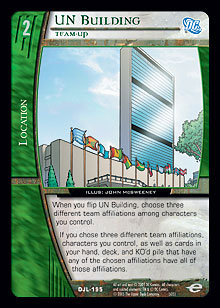 Moving on to resources, there are a few cards that I consider essential in an Ahmed-based deck. Brother I Satellite, Checkmate Safe House, Brother Eye, Enemy of My Enemy, and Slaughter Swamp are all irreplaceable, and the single copy of UN Building that was so useful in Deep Green will stay, given the splashed characters and three primary teams.
Moving on to resources, there are a few cards that I consider essential in an Ahmed-based deck. Brother I Satellite, Checkmate Safe House, Brother Eye, Enemy of My Enemy, and Slaughter Swamp are all irreplaceable, and the single copy of UN Building that was so useful in Deep Green will stay, given the splashed characters and three primary teams.
The next thing we will need is an insurance policy for Ahmed. The most popular insurance card for Ahmed so far has been The Science Spire, but that’s not an option we have available, sadly. We will play The Alley to stop Total Anarchy and Fatality, Flawless Victory from taking us on combat-phase trips to Frowntown, and we already have Huntress to stop targeted plot twists, so we do have some insurance. Given the prevalence of Terra, Tara Markov in Golden Age, however, a single copy each of Dr. Fate’s Tower and Cloak of Nabu will also be necessary. Threat Neutralized is a little underwhelming and takes up a lot of space in the deck, but I’ll keep it in mind for later. New Genesis can allow us to recover with a KO effect on the chain, and Yancy Street can protect all our stunned characters from targeted effects. I consider The Alley a necessity, and New Genesis seems more flexible than Yancy Street, allowing us to trade cards in hand for characters on the board. Plus, the cosmic counter is particularly useful for Scott Free ◊ Mister Miracle.
There are other locations we’ll be including. Rook Control and Coast City provide a powerful pair of effects for forcing our opponents to attack in an order they’re not happy with, as well as providing the option of moving key characters to the hidden area by recruiting Ahmed hidden and switching them over. The Source really has the potential to catch our opponents, stripping out key plot twists on any turn from 3 onward. After we use one, our opponent will probably head too far the other way, playing around more copies of The Source for the rest of the game. That psychological advantage is part of the appeal of the card and means that we won’t actually need to have a second copy in our deck for our opponent to play around it.
Other Resources
As for plot twists, three copies of Enemy of My Enemy will be the starting point. We have a minimum of splashed characters; can team-up easily, using Satellite to hit our drops; and have Sturmer as a supplemental search card. After that, our consideration is a way to ready Takion should we need to do so in the turn 6 recovery phase after using New Genesis, Izaya, or some other recovery effect. The two contenders are Press the Attack and Cosmic Radiation, and without being able to guarantee enough non-stunned characters to run Press the Attack, Cosmic Radiation is it. If Takion actually reaches the recovery phase ready, each copy of Cosmic Radiation we draw lets us put another resource into play, giving us the possibility of skipping straight up to 9 or even 10 resources. On the other side of the fence, against stall decks, we can actually use Cosmic Radiation with Asmodeus to take the effective turn number down. Cosmic Radiation is also useful with Annihilation Protocol and Ahmed, making it a pretty nice fit for the deck as a whole.
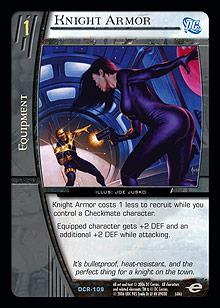 Knight Armor, which was included in the original Deep Green deck, will stay for similar reasons; it is a permanent DEF pump that can also prevent stunbacks very efficiently. At the moment, I don’t have any of the recovery plot twists included in the original list, and I’ll have to see how the deck looks as a whole before I get a feel for whether or not they’ll be necessary. A quick look at the list I have so far suggests one immediate change: Metron, Time Traveler for Mr. Fantastic, Stretch. The ability to use Knight Armor on multiple attacks in a turn or move Cloak of Nabu in response to targeted effects seems much stronger than Metron’s cosmic plot twist negation, and Stretch also doesn’t have the problem of loyalty. Also, having Stretch would give us a New God and a member of the Fantastic Four at both the 4- and 5-drop point on the curve.
Knight Armor, which was included in the original Deep Green deck, will stay for similar reasons; it is a permanent DEF pump that can also prevent stunbacks very efficiently. At the moment, I don’t have any of the recovery plot twists included in the original list, and I’ll have to see how the deck looks as a whole before I get a feel for whether or not they’ll be necessary. A quick look at the list I have so far suggests one immediate change: Metron, Time Traveler for Mr. Fantastic, Stretch. The ability to use Knight Armor on multiple attacks in a turn or move Cloak of Nabu in response to targeted effects seems much stronger than Metron’s cosmic plot twist negation, and Stretch also doesn’t have the problem of loyalty. Also, having Stretch would give us a New God and a member of the Fantastic Four at both the 4- and 5-drop point on the curve.
At the moment, the 2-drop slot is still a little up in the air. Probably the biggest reason for this is that although Invisible Woman, Sue Storm is nominally our primary 4-drop, she isn’t actually significantly better than Izaya. The endurance that Sue Storm saves by preventing some breakthrough (probably not all that much, given our high-DEF characters, Knight Armor, and cards like Coast City to ensure that we can manually reinforce) can also be saved by Izaya recovering an extra character for the next turn. A New Gods 2-drop also gives us earlier access to The Source, which could be important in some matchups. Our flexible approach to the 4-drop, combined with our desire to recruit characters of both teams, indicates that we can run a single copy of the 4-drop we can more often search for with Brother I Satellite, and multiple copies of the other one. This should give us the greatest chances of having our best choice of 4-drop for the situation in which we find ourselves. The only real reason to change this is if we decide that our drop of choice at the 2- and 4-drop slot will always share a team. That is, if we decide that She-Thing with Invisible Woman, Sue Storm, or Vykin with Izaya are just better for our purposes; this is something to keep an eye out for in testing.
At this point, we have enough to go on to put together a first draft of the deck.
First Draft
Characters
1 Connie Webb, Knight
3 Mr. Mxyzptlk, Troublesome Trickster
4 Vykin, Forever People
1 Sarge Steel, Knight
4 Ahmed Samsarra, White King
1 Sturmer, War Dog
3 Invisible Woman, Sue Storm
2 Izaya ◊ Highfather, The Inheritor
1 Elimination Protocol ◊ OMAC Robot, Army
2 Annihilation Protocol ◊ OMAC Robot, Army
1 Maxwell Lord, Black King
1 Mr. Fantastic, Stretch
1 Scott Free ◊ Mister Miracle, Escape Artist
2 Huntress, Reluctant Queen
1 Takion ◊ Highfather, Josh Saunders
1 Asmodeus, Duke of Hell
1 Thing, The Ever-Lovin’ Blue-Eyed Thing
1 Silver Surfer, Norrin Radd
1 Ghost Rider, Danny Ketch
Plot Twists
3 Enemy of My Enemy
4 Cosmic Radiation
Locations
4 Brother I Satellite
3 Checkmate Safe House
1 UN Building
2 Brother Eye
1 The Source
1 Slaughter Swamp
1 Coast City
1 Rook Control
1 The Alley
1 New Genesis
1 Dr. Fate’s Tower
Equipment
3 Knight Armor
1 Cloak of Nabu
Check back tomorrow to see what changes come in after some initial testing, some more discussion on the balance of New Gods and Fantastic Four characters, and last but not least, play tips that showcase some of the more interesting interactions in the deck.

Welcome back to Deck Clinic. When we left off, we’d just settled on a first draft of a decklist for this week’s patient.
At this point, it’s worth noting the “Wouldn’t It Be Nice” card list (courtesy of the Beach Boys). These are cards that we haven’t found space for yet but would quite like to play. Even if we don’t end up playing any of these cards, I would recommend keeping them in mind; they are some of the more likely cards that you might find useful if you want to adapt the final list to deal with particular local problems:
It’s also worth making a note of the key questions about our current inclusions.
- Is Sturmer, War Dog worth his slot, or is he just a cute trick that doesn’t actually bring value to the deck?
- The big question of which 2-drop? We have two attractive options at 2: She-Thing, Sharon Ventura and Vykin, Forever People. Both have implications for the balance of characters at the 4- and 5-drop points in the curve. Making the right decision here is important.
- Is Thing, The Ever-Lovin’ Blue-Eyed Thing necessary? My instinct says that he will be crucial against controlling decks that run Utility Belt and swarms of small characters, as those decks can negate Asmodeus’s resource-KO activated power and prevent us from easily manipulating the resource count. Using Thing to bounce all those small characters (the likely recipients of the Belts) should open our opponent up to Asmodeus. The question, however, is whether those decks are common enough to justify his inclusion.
- Can we get away without Mikado and Mosha, Roy Harper ◊ Speedy, Mercurial Marksman, or some other way to get free stuns or KO’s on cheap aggressive characters? Of particular concern are the High Voltage 1-drops, led by Electric Eve, King Snake, and Ape X.
- Is our insurance package for Ahmed Samsarra enough to keep him safe? In particular, do we have a problem with recruiting Maxwell Lord on turn 5, given the lack of a “hard” insurance card like Fifth Dimension or The Science Spire? Or can we reliably avoid both Kings being stunned during wrap-up by using recovery effects?
When you finish a first draft of a deck, it’s always a good idea to have a good think, do a bunch of solitaire test draws to get a feel for the resource and character curves, and make sure there aren’t serious loyalty issues (something we’ll be looking out for with Scott Free). Play through a few solitaire draws, considering what you’d do in common situations with the available cards. Keep an eye on what your access to off-team characters or searchable resources looks like, whether your resource row is too crowded, and so on.
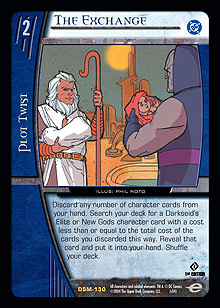 One of the first things that came up is that Sturmer really isn’t as interesting as he looks. For other New Gods decks, the same single copy of Sturmer might be quite useful and provide a handy supplement to The Exchange, but with access to Ahmed-fetched Brother I Satellites and Enemy of My Enemy, Sturmer is just not as good as the fourth copy of Enemy. Other than that, the basic structure of the deck hangs together well. As always, you need to be careful what you set in your resource row, taking into account that, for example, you don’t want three key locations in the row on turn 3, only to find that you need to use Ahmed to search for Dr. Fate’s Tower. OMAC Robots and Mr. Mxyzptlk are good choices for the resource row, as they can easily be retrieved after being KO’d by Ahmed.
One of the first things that came up is that Sturmer really isn’t as interesting as he looks. For other New Gods decks, the same single copy of Sturmer might be quite useful and provide a handy supplement to The Exchange, but with access to Ahmed-fetched Brother I Satellites and Enemy of My Enemy, Sturmer is just not as good as the fourth copy of Enemy. Other than that, the basic structure of the deck hangs together well. As always, you need to be careful what you set in your resource row, taking into account that, for example, you don’t want three key locations in the row on turn 3, only to find that you need to use Ahmed to search for Dr. Fate’s Tower. OMAC Robots and Mr. Mxyzptlk are good choices for the resource row, as they can easily be retrieved after being KO’d by Ahmed.
Thing doesn’t seem to be necessary. I wouldn’t play him unless you have an unusually large number of Utility Belt–packing, Alfred Pennyworth, Faithful Friend decks being played. Against everything other than Utility Belt decks, seven resources is the least likely number for the game to see.
She-Thing turns out to not be nearly as effective against High Voltage as hoped. With a decent draw, High Voltage is capable of protecting its equipped characters, and without Mikado and Mosha to clear the way, her equipment removal ability is unlikely to trigger. The other downside with She-Thing is that, unlike Vykin, She-Thing only provides easier access to your 4- and 5-drop, making it marginally more likely that you will be unable to search for Takion on turn 6. For these reasons, along with the added utility that the Vykin curve gets from The Source and New Genesis (Ahmed searching out New Genesis on turn 3 against Teen Titans has the potential to keep your opponent’s entire board exhausted), I would recommend the Vykin curve.
Without the possibility of searching for Invisible Woman, Sue Storm with Brother I Satellite, I recommend the inclusion of a copy of Merlyn, Deadly Archer, one of my favorite cards, as an alternate 4-drop that can be fetched with Enemy if we need it. (As if anyone could doubt that I’d include a copy in a Checkmate deck with Ahmed Samsarra . . .) Sue Storm will earn a single slot, as with the odd initiative she enables the quite brutal set-up of herself, Annihilation Protocol, and Ahmed. This doesn’t seem too scary until you throw a Cosmic Radiation into the mix, resulting in the KO’ing of most of your opponent’s board.
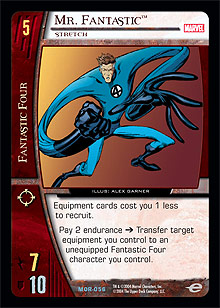 Mr. Fantastic, Stretch can stay on his own merits; the ability to move both Cloak of Nabu and Knight Armor around proved extremely powerful, and with a Fantastic Four team-up, he enables Cosmic Radiation. With his high DEF, a useful ability, and a useful affiliation, he is the 5-drop we will want to recruit in most situations. Against certain decks, we will need to recruit Scott Free ◊ Mister Miracle, Escape Artist on turn 5 simply to keep our endurance total high, and sometimes we won’t have a copy of Enemy of My Enemy to search for Stretch, forcing us to fall back on Maxwell Lord or Annihilation Protocol. Thankfully, we shouldn’t need to use Cosmic Radiation to ready Takion very often; the combination of Coast City, Rook Control, New Genesis (on a character protecting him), and the defensive equipment makes him a surprisingly tough cookie to crack. Against Titans, you will want to make sure that you have Cloak of Nabu on the table when you recruit Takion so you can protect him from Roy Harper ◊ Arsenal, Sharpshooter.
Mr. Fantastic, Stretch can stay on his own merits; the ability to move both Cloak of Nabu and Knight Armor around proved extremely powerful, and with a Fantastic Four team-up, he enables Cosmic Radiation. With his high DEF, a useful ability, and a useful affiliation, he is the 5-drop we will want to recruit in most situations. Against certain decks, we will need to recruit Scott Free ◊ Mister Miracle, Escape Artist on turn 5 simply to keep our endurance total high, and sometimes we won’t have a copy of Enemy of My Enemy to search for Stretch, forcing us to fall back on Maxwell Lord or Annihilation Protocol. Thankfully, we shouldn’t need to use Cosmic Radiation to ready Takion very often; the combination of Coast City, Rook Control, New Genesis (on a character protecting him), and the defensive equipment makes him a surprisingly tough cookie to crack. Against Titans, you will want to make sure that you have Cloak of Nabu on the table when you recruit Takion so you can protect him from Roy Harper ◊ Arsenal, Sharpshooter.
With New Gods characters as the primary drops on turns 2 and 4, we should be able to rely on Brother I Satellite for our core curve. A single Enemy of My Enemy can search for Mr. Fantastic or Silver Surfer, the former also allowing the latter to be searched out with Satellite. Sticking to a Checkmate / New Gods core curve also justifies removing UN Building for the fourth copy of Checkmate Safe House.
The only final change is to add a copy of Straight to the Grave. It’s another search card, but one that can net us cards in hand (when played from the resource row to fetch Mr. Mxyzptlk or an OMAC), and after turn 3, can always fetch a needed character after Ahmed searches for Slaughter Swamp. Mainly, it improves our odds of hitting our off-team drops of choice in the mid-game (such as the Fantastic Four characters at 4 and 5 if we feel we’ll need Cosmic Radiation on turn 6, or Asmodeus at 6).
Without any further ado, here’s the final list I would recommend taking out for a spin.
Final List
Characters
1 Connie Webb, Knight
3 Mr. Mxyzptlk, Troublesome Trickster
4 Vykin, Forever People
1 Sarge Steel, Knight
4 Ahmed Samsarra, White King
3 Izaya ◊ Highfather, The Inheritor
1 Invisible Woman, Sue Storm
1 Merlyn, Deadly Archer
1 Elimination Protocol ◊ OMAC Robot, Army
2 Annihilation Protocol ◊ OMAC Robot, Army
1 Mr. Fantastic, Stretch
1 Maxwell Lord, Black King
1 Scott Free ◊ Mister Miracle, Escape Artist
2 Huntress, Reluctant Queen
1 Takion ◊ Highfather, Josh Saunders
1 Asmodeus, Duke of Hell
1 Silver Surfer, Norrin Radd
1 Ghost Rider, Danny Ketch
Plot Twists
4 Enemy of My Enemy
1 Straight to the Grave
3 Cosmic Radiation
Locations
4 Brother I Satellite
4 Checkmate Safe House
2 Brother Eye
1 The Source
1 Slaughter Swamp
1 Coast City
1 Rook Control
1 The Alley
1 New Genesis
1 Dr. Fate’s Tower
Equipment
4 Knight Armor
1 Cloak of Nabu
Play Notes
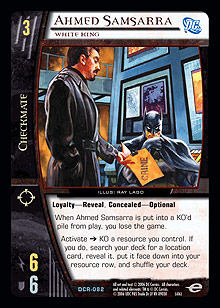 Two specific decks deserve special mention, as even a cursory glance at the results of the recent Golden Age $10K tournament would indicate: Teen Titans and High Voltage. Of the two matchups, Teen Titans will be the more straightforward. There are a few key things you will need to do: The first is recruit Ahmed Samsarra to the hidden area. Titans will generally have no way to reach him, which also means you can get maximum benefit from Rook Control later on. The second is to set up to avoid Terra, Tara Markov being able to stun Ahmed Samsarra if possible; if you have the odd initiatives, you’ll want to use Ahmed to search for Dr. Fate’s Tower and search for Cloak of Nabu, equipping it to Ahmed that turn. With the even initiatives, you can afford to wait until the build phase of turn 4 (although it may not be correct to do so).
Two specific decks deserve special mention, as even a cursory glance at the results of the recent Golden Age $10K tournament would indicate: Teen Titans and High Voltage. Of the two matchups, Teen Titans will be the more straightforward. There are a few key things you will need to do: The first is recruit Ahmed Samsarra to the hidden area. Titans will generally have no way to reach him, which also means you can get maximum benefit from Rook Control later on. The second is to set up to avoid Terra, Tara Markov being able to stun Ahmed Samsarra if possible; if you have the odd initiatives, you’ll want to use Ahmed to search for Dr. Fate’s Tower and search for Cloak of Nabu, equipping it to Ahmed that turn. With the even initiatives, you can afford to wait until the build phase of turn 4 (although it may not be correct to do so).
On turn 5, Mr. Fantastic, Stretch and Maxwell Lord, Black King both have appeal. Maxwell, going into turn 6, can restrict usage of Roy Harper ◊ Arsenal, Sharpshooter to the build phase, while Mr. Fantastic can move Cloak of Nabu with Roy activations on the chain.
On turn 6, Takion will hopefully end up in the hidden area via Rook Control with Cloak of Nabu protecting him from direct stuns from Roy Harper. Skip to turn 8, Enemy of My Enemy for Ghost Rider, Danny Ketch, and end the game with an activation.
Obviously, it won’t always play out quite this simply, particularly if the Titans players you’re facing run Meltdown (only some do) to KO Cloak of Nabu. Even if they do KO the Cloak, your recovery effects, hidden characters, and Huntress, Reluctant Queen should prevent your opponent from seriously exploiting direct stuns, multiple team attacks, and Removed from Continuity to gain board presence. If your opponent KO’s the Cloak of Nabu, then you’ll need to keep your board presence up with Izaya and New Genesis, protecting key characters (particularly Izaya himself) with Rook Control and Coast City.
High Voltage is much tougher and the more difficult of the two matchups, and this highlights the biggest difficulty when it comes to building decks for current Golden Age. Building decks that can beat either Teen Titans or High Voltage is a perfectly achievable aim. Unfortunately, building a deck that can reliably beat both and still be resilient enough to handle the less conventional or predictable decks is a huge undertaking. However, there are some things you can do to improve matters: The first is to recruit Ahmed in the visible area, ideally with a Knight Armor. If you hit Vykin, equipping a Knight Armor to him will help as well, making you more likely to keep characters exhausted going into turn 4.
On turn 4, if you have the initiative, go for Merlyn, Deadly Archer if possible and KO Black Panther, King of Wakanda. On turn 5, Annihilation Protocol is probably the best; the OMAC can attack or be attacked and then be recovered with New Genesis or Izaya after trading stuns with an opposing character, allowing one of your non-Army characters to be exhausted for the KO. If this keeps Deathstroke the Terminator, Lethal Weapon or Golden Archer, Wyatt McDonald off the table, the endurance you’ll save on the next turn will quite possibly outweigh the damage you can do on the attack. In this matchup, you’ll need to balance your options carefully on turn 6; this is one matchup where you will quite possibly not want to use Asmodeus or Takion and instead choose to attack to force damage through. Either 8-drop should be sufficient to dominate the board if you go with the Takion plan. Which one you’ll want to use will vary depending on your endurance total and your opponent’s board position.
Final Thoughts
I hope you’ve enjoyed reading about this deck as much as I’ve enjoyed tinkering with it. Unlike with the Morlock deck that I featured in the first Deck Clinic, I’ve hopefully been able to shed some light this time on how best to set up a particular board position from which you will consistently win the game. In this case, that position is a particular 6-drop, ready and unstunned during the recovery phase of turn 6, along with an 8-drop or a way to search for an 8-drop. Making the achievement of that position more reliable involved making some significant changes, particularly the shift toward and then back away from a Fantastic Four-heavy curve rather than the final curve of primarily Checkmate and New Gods characters.
Working out the most reliable way to set up such a position while also taking into consideration the fact that your churlish opponent will be busy trying to do Bad Things to your characters is one of the best deckbuilding skills you can practice if you have any interest in playing controlling or stalling decks. Sometimes, you have to work backward from that position. If Takion is stunned when the recovery phase rolls around, how am I going to get him working again? What good, on-team, 8-drops and higher are there to search for with Brother I Satellite if I don’t draw Enemy of My Enemy? Finding answers to those questions can be the key to understanding how a deck can work, and can also send up a warning signal that a deck won’t work if we need too many things to go right to set up a particular goal. In this case, the demands made on us aren’t too great as far as many matchups go, although we have problems with the super-fast High Voltage deck. To be fair, this leaves us in quite illustrious company; High Voltage isn’t the easiest deck in the world to beat consistently while remaining competitive against anything else.
As usual, if you have any ideas for future editions of the Deck Clinic, email them to me at vsdeckclinic@googlemail.com.